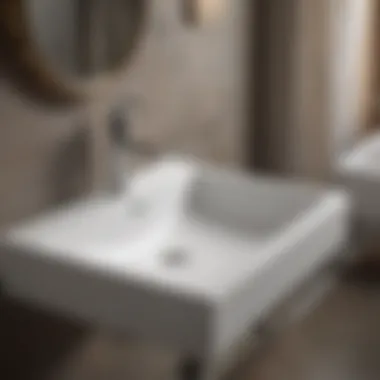Essential Features of ADA Approved Bathroom Sinks


Intro
Creating a bathroom that’s not only visually appealing but also caters to everyone’s needs is no small feat. This is where ADA approved bathroom sinks come into play. These sinks are designed with accessibility in mind, ensuring that individuals with diverse needs can navigate a space with ease and confidence.
In recent years, awareness about inclusivity in design has surged, making it imperative for homeowners to understand the Americans with Disabilities Act (ADA) guidelines. By incorporating these features, homeowners contribute to a space that embodies accessibility while still aligning with modern aesthetics.
The significance of ADA compliance extends beyond mere regulations; it embodies a commitment to fostering an inclusive community. The world is diverse, and recognizing that our homes should reflect that diversity enhances not just usability but also our shared experience of comfort and safety. With this guide, we will explore trending styles and color palettes that harmonize aesthetics with functionality.
This narrative serves as a beacon for anyone interested in upgrading their bathroom with ADA approved sinks. We'll unpack the essentials with depth, leaving no stone unturned in your journey towards understanding and selection.
Prelims to ADA Regulations
In today’s world, creating spaces that cater to the diverse needs of every individual has become a fundamental consideration in design. The Americans with Disabilities Act is pivotal in this endeavor, specifically when it comes to bathroom sinks. This section lays down the groundwork by detailing the importance of ADA regulations and their impact on bathroom design, ensuring accessibility remains a priority.
Understanding the Americans with Disabilities Act
The Americans with Disabilities Act (ADA), enacted in 1990, works to eliminate barriers in public places and ensures individuals with disabilities have equal opportunities. It's not just about providing ramps or wider doorways; the ADA extends its reach into every facet of design, including bathroom amenities.
According to ADA guidelines, facilities must be equipped with features that promote access for all. This includes height specifications for sinks, clearance under the basin, and easy-to-use fixtures. Understanding these regulations not only ensures compliance but also enhances user experience for those who may find traditional designs challenging.
For instance, a standard sink setup can be difficult for someone in a wheelchair, making it essential to adapt height and width according to ADA standards. The resulting design isn't just beneficial for those with disabilities; it promotes a welcoming environment that prioritizes comfort for everyone.
Impact on Bathroom Design
When it comes to bathroom design, the impact of the ADA is profound. Changing the blueprint of how bathrooms are constructed, it emphasizes the importance of thoughtful layout choices and functional elements. Here’s how ADA regulations influence bathroom design:
- Height Specifications: Ensuring sinks are neither too low nor too high is key. ADA guidelines recommend a height of 34 inches for the sink rim.
- Clearance Requirements: Sufficient clearance underneath the sink (typically around 29 inches) fosters a more accommodating space for wheelchair users.
- Design Elements: This can include considerations for faucet types, using lever operable or touchless models for ease of use.
Designing with ADA compliance in mind doesn't obstruct stylistic creativity; rather, it offers an opportunity to integrate elegance with functionality. Many modern bathrooms showcase the significance of these regulations by featuring stylish, ADA-compliant sinks that blend seamlessly into a chic interior.
Moreover, implementing ADA standards often leads to designs that appeal to a broader audience. It can enhance the value of a home or business, as more people realize the importance of functionality alongside aesthetics. As such, adopting these regulations is not only a moral and legal obligation but also a smart business strategy—serving the needs of all users while enhancing overall appeal.
Defining ADA Approved Bathroom Sinks
Understanding what qualifies as an ADA approved bathroom sink is crucial for anyone looking to enhance accessibility in their space. These sinks are designed with specific features to cater to a diverse range of users, ensuring that everyone, regardless of mobility challenges, can utilize them comfortably. Incorporating ADA compliant sinks into your home or facility not only improves accessibility but also demonstrates a commitment to inclusivity.
Key Features of ADA Approved Sinks
Height Specifications
Height specifications play a pivotal role in defining ADA approved sinks. The Americans with Disabilities Act suggests that these sinks should be mounted so the rim is between 34 and 36 inches from the floor, which is a height range that allows for ease of use by people using wheelchairs or with limited reach. This height consideration is a beneficial design aspect, promoting user independence and comfort.
Moreover, you might find that some models are adjustable, which brings an additional edge to users with varying physical requirements. The unique feature here is the versatility. However, if not installed correctly or used in spaces with low ceilings, it could present some challenges for taller individuals.
Clearance Requirements
Clearance requirements are another essential aspect. The ADA mandates at least 27 inches of knee clearance for users in wheelchairs. This requirement allows for comfortable access to the sink without pressure points harming knees or legs. Such specifications enhance usability immediately.
In addition, many designers emphasize an open vanity design to further accommodate this clearance, allowing caregivers or family members easy access while assisting individuals with disabilities. Still, keep in mind that an overly open space may run the risk of compromising aesthetics, so a balance must be struck.
Design Elements
Design elements encompass shape and style, which are not to be overlooked. Round and oval sinks are often more accommodating due to their soft edges, while rectangular sinks may fit snugly in modern aesthetics. Both types can meet ADA standards when they maintain the necessary height and clearance requirements.
Also, choosing materials that are easy to clean not only helps maintain hygiene but also assists individuals who might have difficulty handling complex cleaning tasks. The unique feature here is that while function is paramount, visual appeal is also considered vital. However, sometimes, having a more artistic design might reduce the focus on accessibility, which could be a disadvantage.
Benefits of Using ADA Compliant Sinks
Enhanced Accessibility
ADA compliant sinks significantly improve accessibility. These sinks are crafted to be used comfortably by individuals of all abilities, including seniors or people with temporary disabilities. When you choose such sinks, you’re not just following regulations—you’re making your home or business significantly more welcoming.
A key characteristic is how they facilitate independence, as individuals no longer have to rely heavily on assistance for basic tasks such as handwashing or personal grooming. It is a beneficial choice that resonates with a broader audience. The best part? Increased accessibility often results in better traffic and customer satisfaction for businesses.
User Comfort


User comfort is at the heart of ADA approved designs. Think about the variety of users, each with different needs. A well designed sink considers this diversity, and the ergonomic design can help prevent strain from bending or reaching.
Features such as lever handles or touchless faucets further enhance ease of use, making a noticeable impact on the daily routines of users. However, not every comfort solution suits everyone; sometimes what is comfortable for one may be impractical for another. Evaluating a broad spectrum of user needs is, therefore, highly beneficial.
Broader Market Appeal
By choosing ADA compliant features in your bathrooms, you open the doors to a broader market appeal. Properties and businesses that showcase a commitment to accessibility often attract more visitors, hence expanding their clientele.
The key characteristic of having ADA approved facilities is that they often become preferred choices among particular demographics, solidifying a positive reputation. Nevertheless, some might think these designs may compromise luxury for functionality, but that’s a misconception because luxury can manifest in many forms, even in a space designed for accessibility.
"Creating spaces that accommodate all is not just a regulatory requirement; it’s a lifestyle statement of valuing inclusivity and comfort for everyone."
In short, defining ADA approved bathroom sinks involves understanding their functional aspects and benefits, which ensures that they serve a crucial role in modern bathroom design.
Materials and Design Options
When it comes to ADA approved bathroom sinks, the materials and design options play an essential role in ensuring that these fixtures not only meet accessibility standards but also blend seamlessly into a variety of bathroom aesthetics. Choosing the right materials and designs is not just a matter of style, it's about functionality, ease of use, and the overall user experience. Here, we will delve into the common materials used for bathroom sinks, focusing on their unique characteristics and how they contribute to an accessible bathroom design.
Common Materials for Bathroom Sinks
Porcelain
Porcelain sinks have long stood as a classic choice in bathroom design. Their smooth, glossy surface reflects light beautifully, adding an air of elegance to any space. One of the standout characteristics of porcelain is its durability; it can withstand both heat and frequent use without showing wear and tear. In terms of ADA compliance, porcelain sinks are often designed to be easily accessible with the right height and clearance.
Moreover, one unique feature of porcelain is its ease of cleaning, which is a significant advantage for maintaining hygiene standards in a bathroom that accommodates all users, including those with disabilities. However, there are downsides—porcelain can chip or crack under impact, and can be heavier than other materials, which may pose a challenge during installation.
Composite
Composite sinks, made from materials like resin, fiberglass, and stone, present another option for ADA compliant bathrooms. These sinks often mimic the look of natural stone but come with added benefits like resistance to stains and scratches. The flexibility in design options is a notable characteristic; composite sinks can be molded into various shapes and textures.
Using composite materials can be a beneficial choice as they are lightweight compared to porcelain, making them easier to handle during installation. However, while they offer durability and design versatility, some composites may not be as heat resistant as other options, which could be a consideration for users who frequently use hot water.
Stainless Steel
Stainless steel is often the unsung hero of bathroom sinks. With its sleek, modern appearance, it's a go-to choice for many contemporary bathrooms. The key characteristic of stainless steel is its exceptional durability; corrosion-resistant and easy to clean, it stands the test of time with minimal maintenance.
From an ADA perspective, stainless steel sinks often feature rounded edges and smooth surfaces, which can greatly enhance safety for users with limited mobility. The unique feature of stainless steel is its ability to blend with various design elements, making it a flexible option whether you're aiming for an industrial or a warm, inviting bathroom atmosphere. However, the main drawback could be the potential for scratches, which might require more attention to maintain its pristine look.
Aesthetic Considerations in Sink Design
The visual aspect of a bathroom sink is just as important as its functionality, especially in spaces that strive for a harmonious blend of style and accessibility. The following subsections detail important aesthetic considerations when selecting ADA approved sinks.
Color Choices
Color choices can profoundly impact the overall vibe of a bathroom. A well-chosen hue can elevate the space, making it feel either calm and soothing or vibrant and energetic. For ADA approved sinks, selecting colors that harmonize with other bathroom elements is crucial for creating an inclusive space.
Neutral shades are often popular as they can easily blend in with any surrounding decor. Yet, using a pop of color can make a statement and contribute to a positive experience for users. However, be cautious—darker colors may show water stains more easily, requiring more maintenance.
Shape Variations
Shape variations in sinks can dictate the flow and feel of a bathroom. Rounded or oval shapes often provide softer lines, which could be more inviting and fitting for users who are visually impaired. Meanwhile, angular or rectangular designs offer a modern edge. The choice of shape should not only align with personal style but also consider the ease of use. A deeper sink might help prevent splashes, adding to user comfort. Yet, it is essential to weigh aesthetic choices against functionality to ensure the sink remains practical for all users.
Integration with Bathroom Decor
Integrating the sink with the broader bathroom decor is vital for achieving a cohesive look. This aspect means ensuring that the materials, colors, and styles of the sink complement cabinets, tiles, and fixtures. An integrated approach not only enhances visual appeal but also contributes to a sense of unity and calm in the space, which can benefit all users.
A successful integration should also account for practical aspects like maintenance and care. For example, if other elements in the bathroom are high maintenance, choosing smoother, stain-resistant materials for the sink can alleviate some of that pressure. The challenge lies in striking a balance between personal style and functional needs, ensuring ADA compliance while also reflecting the homeowner's taste.
Installation Guidelines
When it comes to ADA approved bathroom sinks, installation is just as critical as the design elements themselves. We often think about how a sink looks or its materials, but the practicalities of installation play a huge role in ensuring a space is truly accessible. It's not merely about putting a sink in; it’s about making sure that it meets specific standards and serves its purpose effectively. A well-installed sink not only complies with regulations but also enhances user experience, enabling individuals with various mobility challenges to easily access and use the facilities.
Height and Depth Specifications
One of the most compelling aspects of ADA compliance is the size and height specifications for sinks. The Americans with Disabilities Act suggests that the top of the sink shouldn’t exceed 34 inches from the floor. This guideline is designed to ensure that people in wheelchairs can roll right up to the sink without any obstruction.


When considering depth, it’s worth noting that deeper sinks can prove difficult for short individuals or those in wheelchairs to access effectively. Therefore, keep the depth around 6 to 8 inches for an ideal range, making it functional for everyone. Furthermore, ensuring that there is a knee clearance of at least 27 inches underneath the sink can transform it into a user-friendly setup.
Plumbing Considerations
Plumbing plays a pivotal role in the overall effectiveness of an ADA compliant sink. For starters, think about where the plumbing lines will run. If they are too high or too low, they may create difficulties not just for installation but for future access as well. Use flexible drainage pipes wherever possible, as these can better accommodate unique layouts.
It is also critical for the faucet controls to be levers, as they typically require less effort to operate. Positioning them within a 48-inch reach range ensures that users, regardless of their height or mobility challenges, will find it easy to access them. Moreover, installing a sensor faucet can further improve accessibility by minimizing the need for manual operation.
Accessibility in Installation
Accessibility must be front and center throughout the entire installation process. Begin by assessing the environment where the sink will go. Consider factors like wall placement and overall room layout. This can greatly influence how well a sink will serve its purpose. Using the right tools and employing accessible installation practices is fundamental.
When making adjustments, ensure that the sink and any additional fixtures around it are installed without any protruding edges, which can be a hazard for someone using a mobility aid. It's also advisable to allow at least 30 inches of clear floor space in front of the sink. This ensures a wheelchair can fit comfortably, and it promotes safety as well.
Remember, a sink is not just a fixture; it's a pivotal element that can ensure independence and dignity for many users.
As any seasoned homeowner or designer will attest, taking the time to carefully consider these installation guidelines can turn a simple bathroom into an inviting and accessible space. Following the standards means not just compliance but a commitment to inclusivity and user comfort.
Choosing the Right ADA Approved Sink
Selecting the appropriate ADA approved sink holds fundamental significance in creating a user-friendly and accessible bathroom environment. Without a doubt, this selection process demands careful consideration of various elements, ranging from the physical space available to the specific needs of users. In doing so, homeowners not only ensure that their bathrooms comply with ADA regulations but also enhance the overall aesthetic and functional appeal of the space.
Navigating this selection can feel overwhelming, if you don't know where to begin. Therefore, this section breaks down three crucial aspects that should guide your choice: assessing your space, evaluating user needs, and budgeting for ADA products.
Assessing Your Space
Before diving headfirst into options, it is vital to take stock of the physical environment where the sink will reside. An accurate assessment of your space involves measuring the dimensions of the bathroom and considering how the sink will integrate with other fixtures.
- Size and Layout:
Begin by measuring the dimensions of the area designated for the sink. Take note of the location of plumbing lines, electrical outlets, and nearby walls. The layout of the bathroom also plays a crucial role in determining how much room is available for the sink. - Accessibility Features:
An accessible sink should have enough maneuvering space for wheelchairs or walkers. Typically, a clear zone of at least 30 inches wide by 48 inches deep in front of the sink is ideal. Moreover, this space allows users to maneuver freely without any obstacles. - Height Considerations:
The height at which the sink is installed is critical. For ADA compliance, sink edges must be no higher than 34 inches from the floor, allowing for easy reach and comfort. A precise measurement guarantees a suitable fit.
By taking the time to assess your space thoroughly, you’ll ensure that whatever sink you choose won’t just meet guidelines but will also merge seamlessly into your existing layout.
Evaluating User Needs
After understanding the space, the next step is figuring out the specific needs of potential users. Different individuals might have varying levels of mobility, height, and overall preferences.
- User Height:
Consider who will primarily use the sink. For instance, if the bathroom is primarily for children, a lower sink height may be beneficial, while a sink tailored for adults may sit higher. - Mobility Challenges:
If users have mobility issues, you may want to consider features like lever handles that are easier to operate or a sink design that allows for knee clearance underneath. Additionally, installing grab bars near the sink can enhance safety and convenience. - Personal Preferences:
Preference plays a large role in sink selection. A sink might meet ADA standards but may not appeal visually or functionally to the user. It’s essential to ensure the design aligns with their tastes while still being practical enough for daily use.
Budgeting for ADA Products
The final consideration in your sink selection is, of course, the budget.
Just like any renovation project, setting a realistic budget is paramount. Here are some guidelines to keep in mind:
- Initial Costs:
ADA approved sinks can range in price based on materials and styles. Plus, you need to factor in installation costs that might come along with complex plumbing adjustments. - Long-Term Savings:
Investing in quality products might seem expensive upfront, but it can yield significant savings in the long run. Upgrading to sustainable or durable materials can minimize maintenance and replacement costs. - Incentives and Funding:
Check for local grants or programs that support home modifications for accessibility. Many states offer financial aid for those who seek to improve their living conditions.
Ultimately, the goal is not only to meet legal requirements but also to create a space that promotes dignity and ease of use for everyone.
Trends in ADA Approved Bathroom Design
The landscape of bathroom design is constantly evolving. One area that has gained particular traction in recent years is the integration of ADA approved features. This is not merely a regulatory requirement; it's a reflection of shifting societal attitudes toward accessibility. Designing bathrooms that accommodate all users fosters an inclusive environment, and this trend is becoming increasingly prevalent. By focusing on current innovations and sustainable options, homeowners can create spaces that are both functional and aesthetically pleasing.
Current Design Innovations
To stay abreast of trends in ADA approved bathroom sinks, one might observe several noteworthy innovations.
- Smart Sinks: Modern technology now intertwines with bathroom fixtures. Smart sinks offer features like touchless faucets that help with both hygiene and accessibility. These options are ideal for people with mobility challenges, as they eliminate the need to manipulate taps in potentially uncomfortable positions.
- Adjustable Height Sinks: Imagine a sink that can adapt its height! With the rise of adjustable or retractable sink designs, users can tailor their experience according to their unique requirements. This personalization can significantly enhance comfort, especially for those who may rely on wheelchairs or require extra support.
- Integrated Technology: Sinks equipped with integrated lighting and temperature controls improve user experience. For instance, a color-changing LED light may signify water temperature, offering a visual cue that aids in preventing burns. This is especially beneficial for older adults who might have diminished sensitivity.
"Modern bathrooms are becoming more than just functional. They're evolving into welcoming spaces built with everyone in mind."
The growing appreciation for aesthetics does not overshadow the core principle of accessibility; rather, it complements it, creating harmony between style and function.
Sustainable and Eco-Friendly Options
As global consciousness shifts toward sustainability, bathroom designs reflect this ethos. Eco-friendly bathroom sinks not only align with ADA standards but also contribute to environmentally responsible practices. Here are some noteworthy options:
- Recycled Materials: Choosing sinks made from recycled composites reduces the burden on landfills while retaining style and functionality. These materials can mimic the look of traditional substances but offer a lesser environmental impact.
- Water-Efficient Fixtures: Sinks that utilize less water without sacrificing performance become essential in both eco-friendly and ADA designs. Low-flow faucets can cut down on water usage significantly, making bathrooms more sustainable and compliant.
- Natural Stone Varieties: Opting for materials such as bamboo or recycled glass brings a touch of nature into the bathroom while ensuring durability. These materials can be both visually appealing and practical for ADA compliance, as they often come in varied shapes and heights that suit different needs.


In summary, the trends in ADA approved bathroom design are about context — understanding the importance of accessibility and embracing modern innovations. By integrating these elements, homeowners can create spaces that not only meet regulations but also provide a comfortable, stylish environment for everyone.
Case Studies and Real-Life Examples
Understanding real-world applications of ADA approved bathroom sinks sheds light on not just their functionality, but also their impact on daily living. An informed choice regarding these sinks can significantly enhance the lives of users, whether they be at home or within commercial spaces.
Residential Applications
Imagine a cozy family home where accessibility touches every corner. Homeowners often get faced with the challenge of balancing aesthetic appeal with functionality. Having ADA compliant sinks is not just about meeting regulations; it's about making life easier for every family member. For instance, consider a scenario where a family wants to accommodate an aging parent or a child with disabilities.
- Integration in Home Design: An ADA approved sink seamlessly integrates into the bathroom, ensuring that the space remains inviting without sacrificing practicality. Low-profile designs, with easy access from wheelchairs, are becoming increasingly popular. This inclusivity allows family members to participate in daily routines, fostering a supportive environment.
- Personal Touch: Homeowners might opt for materials like porcelain for its classic look, or composite blends for a modern flair, making the space both beautiful and practical.
- Community Insights: Local initiatives sometimes share success stories about home renovation projects aimed at older citizens, showcasing how minor adjustments, like installing the right kind of sink, transformed their living experiences.
Commercial Implementations
In commercial spaces, the stakes are even higher. Businesses now recognize that a truly inclusive environment not only meets legal requirements but also creates a welcoming atmosphere for all clients and employees.
- Enhanced Customer Experience: Businesses like restaurants and hotels have started to adopt ADA compliant designs by including these sinks in their restrooms. This not only affirms a commitment to accessibility but often impresses customers, notably gaining the edge over competitors.
- Safety Standards: In workplaces, ensuring communal bathrooms have ADA compliant sinks plays a crucial role in meeting safety standards. It allows employees with disabilities to perform their tasks with ease, showing that the company values all its workforce members. An example being open-space theaters or galleries where access ease is part of the experience.
- Marketing Edge: Many businesses report increased patronage after becoming ADA compliant. This is especially evident in service-oriented industries where customer experience is paramount. Consider a hotel that's received praise for its attention to inclusivity, leading to positive reviews and increased bookings through word-of-mouth.
"When accessibility is integrated into design, it reflects respect for all individuals, enhancing their experience and engagement."
Through these case studies—highlighting both residential and commercial implementations—it's evident that ADA approved bathroom sinks carry a message beyond mere compliance. They symbolize a commitment to inclusivity, enhancing functionality and satisfaction, regardless of the user's needs.
While the journey towards full accessibility is ongoing, these examples illustrate how meaningful changes can lead to significant improvements in both personal and public environments.
Potential Challenges and Solutions
Discussing potential challenges and solutions is vital as it unravels the path to effective adoption of ADA approved bathroom sinks. Misunderstandings abound when it comes to what constitutes compliance. It’s crucial for homeowners not to get lost in the weeds of regulations and specifications. As you embark on this journey, knowing these challenges can save time, money, and, most importantly, aggravation down the line.
Common Misconceptions about ADA Compliance
When the term "ADA compliance" comes up, many may tend to think that it solely revolves around having grab bars and lower toilet heights. However, the reality is more nuanced. For instance, a typical misconception is that all bathroom sinks must be at a uniform height of 34 inches. While that is a general guideline, ADA regulations emphasize functionality and user experience. The sink must accommodate various users, not just meet a single height requirement.
Other frequent myths include
- Only public restrooms need to comply: In fact, private residences can also greatly benefit from ADA standards, promoting accessibility for all guests and family members.
- All sinks labeled ADA comply: Not all sinks marketed as ADA compliant may actually fulfill all standards, which means vigilance is necessary when selecting a sink.
These misunderstandings can lead to poor design choices that make an otherwise accessible environment less effective. It’s essential that homeowners seek clarity around these points, perhaps consulting resources from Wikipedia or other informative links, to ensure the sink chosen genuinely complies with ADA requirements.
Addressing Installation Problems
When it comes to installing an ADA approved sink, getting everything right isn't as straightforward as one may think. Homeowners can run into a multitude of errors if they don’t properly plan.
A prevalent problem can include insufficient clearance space, which needs careful measurement during the installation process. A sink may technically be ADA compliant but, if there isn't the necessary clearance beneath it, it’ll render the use impractical. Here are some considerations:
- Ensure that the plumbing beneath the sink permits enough room for wheelchair users to approach with ease.
- Installation needs to consider depth. Putting a sink too deep might impede access.
Additionally, improper installation can lead to a situation known as "trap issues," where pipes end up being positioned incorrectly and lead to leaks or blockages. Regular plumbing checks post-installation can go a long way.
With a proactive approach, homeowners can sidestep these pitfalls and create a truly accessible environment.
Incorporating these considerations into your planning will streamline the process significantly.
For those wanting to dive deeper into related discussions, sites like Reddit can often provide real-life experiences and solutions from homeowners facing similar challenges.'
End
As we draw this exploration to a close, it's vital to reflect on the significance of ADA approved bathroom sinks not just as mere fixtures, but as pivotal elements that shape our living environments. This article aimed to equip homeowners with knowledge and insights, emphasizing the profound impact these sinks have on fostering accessibility, comfort, and inclusivity in bathrooms.
Recap of Key Points
We delved into several areas regarding ADA approved sinks:
- Understanding ADA Regulations: We unpacked the core principles of the Americans with Disabilities Act, revealing how they influence bathroom designs.
- Defining Features: Key features such as height specifications, clearance requirements, and thoughtful design elements make these sinks ideal for enhancing usability.
- Materials and Designs: From porcelain to stainless steel, the material choices were addressed along with aesthetic considerations to suit diverse bathroom styles.
- Installation Guidelines: Practical advice on installation ensured that accessibility and comfort are prioritized from the get-go.
- Future Trends: By examining innovations and sustainable options, we gained foresight into how bathroom designs may evolve further.
The Future of Accessible Bathroom Design
Looking ahead, the future of accessible bathroom design appears promising. Emerging trends indicate an increasing incorporation of technology and sustainable practices, which seem to be not just preferences but necessities in today’s world. More designers are recognizing the aesthetic value in accessibility, leading to smarter, sleeker designs that do not compromise on style.
For instance, smart sinks that adjust their height or have motion sensors for water flow are on the rise. Such advancements could revolutionize the way accessibility is approached, making everyday tasks simpler for everyone. Alongside this, eco-friendly materials and designs are rapidly gaining traction, aligning with a broader societal shift towards sustainability.
"Creating accessible spaces benefits everyone, not just those with disabilities. It promotes an inclusive environment where comfort and usability are prioritized for all."















